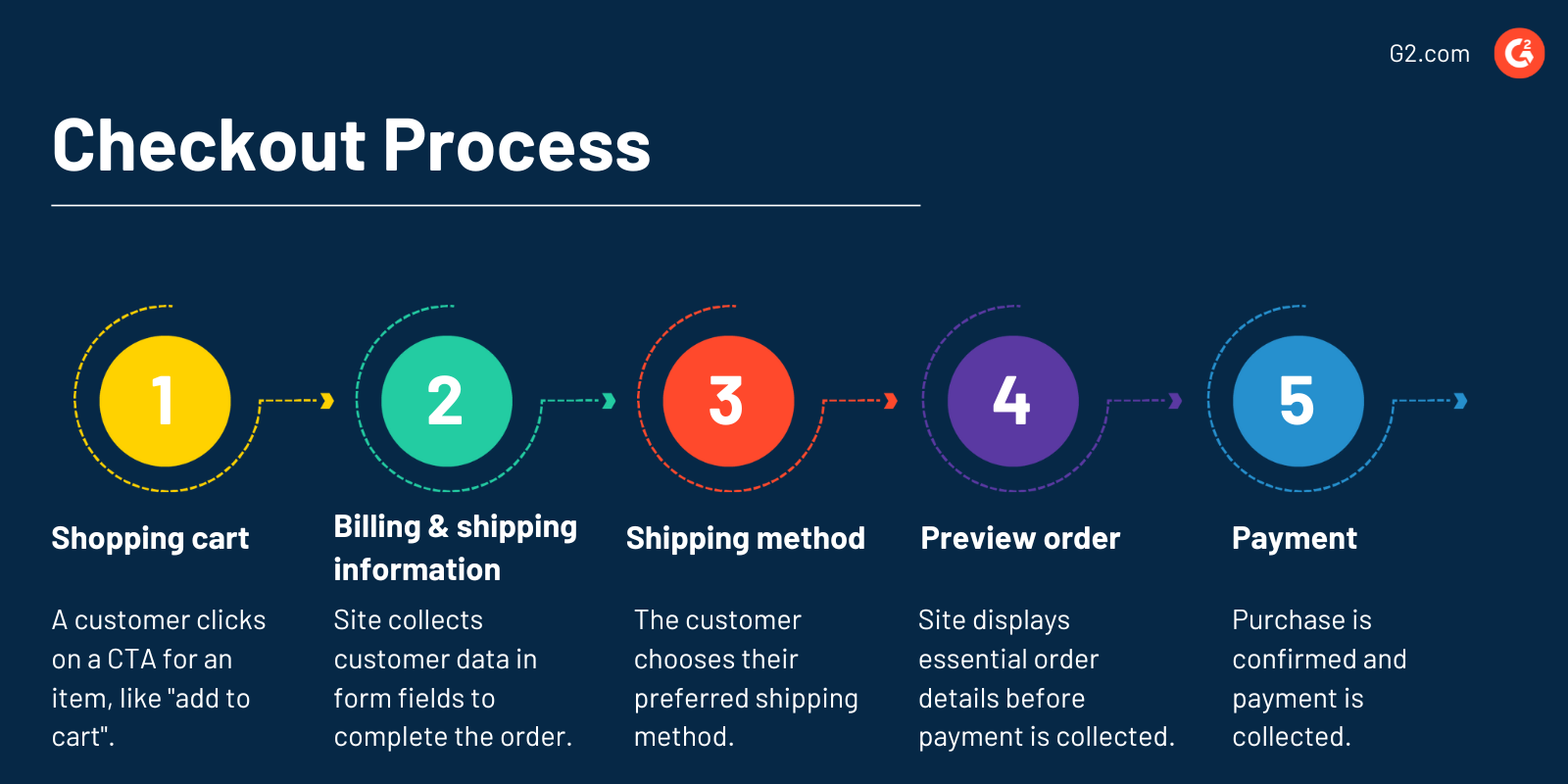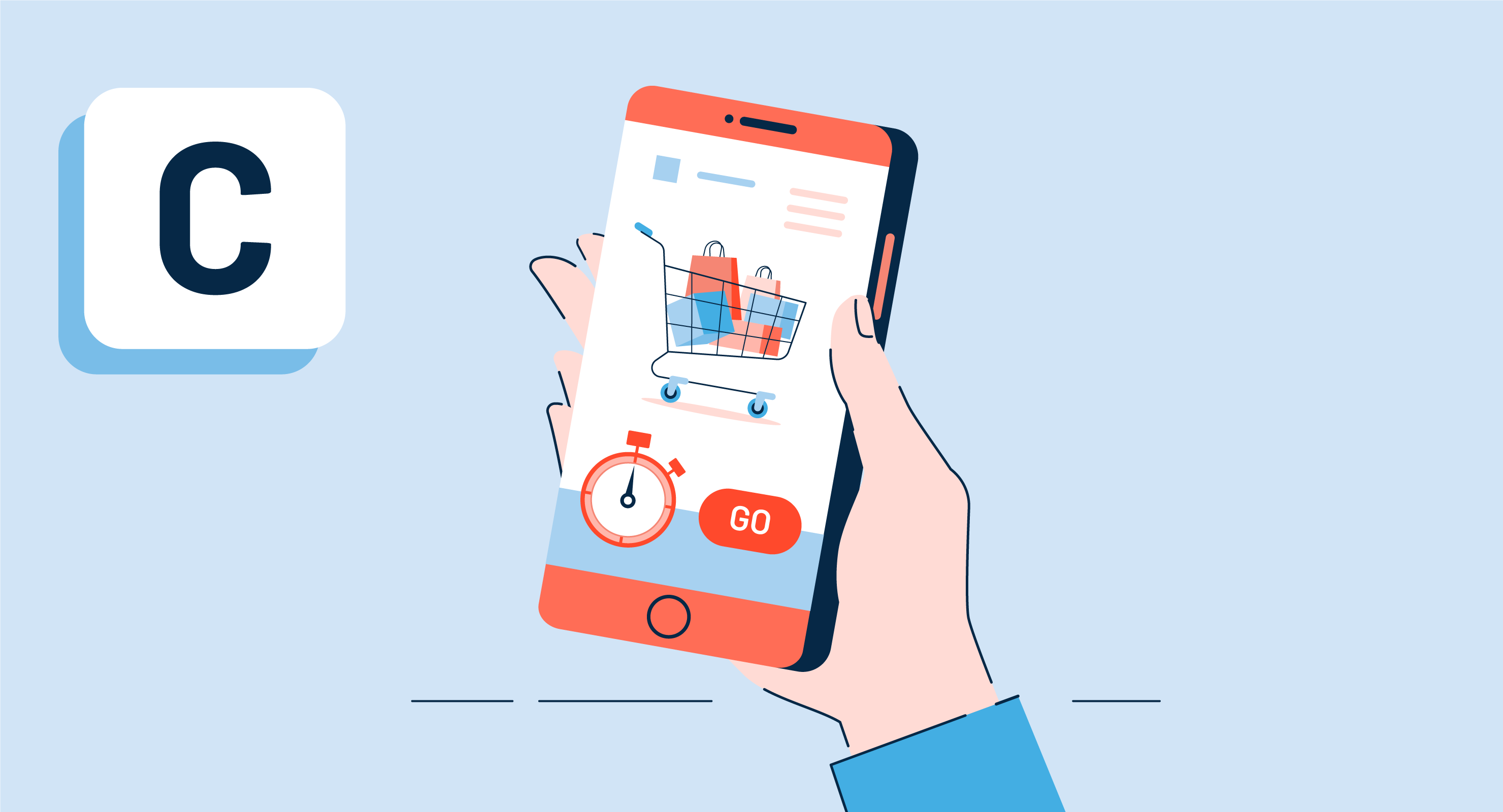What is a checkout process?
The checkout process is a series of steps that a consumer must go through when purchasing items on an online shopping platform. It consists of several phases, including applying promotions and coupon codes, calculating taxes, selecting shipping and payment methods, and so on.
These procedures are carried out through a series of web pages that the consumer must navigate.
The checkout process usually starts when a customer adds the desired products to their shopping cart and successfully passes the initial stages of the process (such as selecting a country and entering basic billing information) and ends with payment confirmation.
Why is a good checkout process necessary?
A good checkout process makes a buyer's transaction as smooth as possible from start to finish and provides more returning customers. For example, an optimized e-commerce checkout process offers a seamless experience for online shoppers, with an uninterrupted path from the product page to the cart page and then finally to the purchase confirmation page.
The more the e-commerce website helps them fill out the information, the more likely it is that the customer will convert positively into revenue.
The checkout process has two critical roles to play here:
- Convert visitors into returning customers
- Collect customer data for future use
Types of checkout processes
Providing a positive customer experience is very important to a company’s bottom line. One of the most daunting tasks for a business is deciding on the type of checkout process for their e-commerce store. An appropriate checkout process needs to be implemented to increase the conversion rate and sales.
There are several types of e-commerce checkout processes available for online retailer websites.
1. One-page checkout
Many businesses use one-page checkout in the hopes that buyers can finalize their purchases as quickly as possible. Customers can submit all of their details (such as shipping information) and complete their purchase without accessing another page, eliminating the need to visit multiple pages.
Buyers become more motivated as they get closer to completing their transactions. When they have to go through several pages, there's a risk that they might not finish the process. Additionally, the one-page approach is more user-friendly and reduces the shopping cart abandonment rate.
Adaptive one-page checkout pages generally flow into a vertical column to fit the mobile screen, which makes it inconvenient for mobile users to browse through one long page.
2. Multi-page checkout
In a multi-page checkout process, the buyers need to browse through several web pages before completing their order. Such a checkout procedure is easier to build since the design team doesn't have to pack as many data fields as possible onto a single page.
This approach isn't as widespread as one-page checkout since it's often assumed that shoppers abandon carts when they have more time to think about their upcoming purchase.
A multi-page checkout makes it easier for businesses to gather data as the data collection process is separated into multiple phases. It is a preferable alternative if businesses are to gather a large amount of information from customers throughout the checkout process.
For example, one of the most common multi-page checkout methods is the two-step checkout, commonly offered by e-commerce platforms.
3. Accordion checkout
The accordion checkout is a more modern type of one-page checkout process, in which stages are shown vertically and may be expanded or collapsed using Asynchronous JavaScript And XML (AJAX).
Accordion checkout consists of a series of headers that may be clicked to expose or hide field forms related to them in a vertically stacked list. Accordion checkouts are ideal for responsive websites because they can quickly scale up and down. Buyers can promptly change the data in the form fields without going back to the previous page.
The accordion checkout process is steadily gaining popularity as the preferred method of the e-commerce checkout process.
What are the standard checkout process steps?
The checkout process is one of the essential steps in conversion rate optimization (CRO). To provide a quality checkout experience, retailers need an appropriate quantity and quality of checkout steps. The right process is not complex, and it should be easy for customers to follow.

Businesses must gather precise details from the customers irrespective of how they package their checkout page, including:
- Shopping cart: The checkout process starts with the shopping cart. This is accomplished through the use of a call to action (CTA) button, generally labeled as "Checkout" or "Buy Now". When a buyer selects this option, they are sent to the checkout page.
- Billing information: Collecting billing information is a critical phase in every checkout process. Billing information, such as adding the billing address, should be validated and form fields intuitively structured to fit all needed details.
- Shipping information: Businesses collect shipping information (such as the shipping address) using a simplified set of form fields. They can simplify this step with the help of a checkbox to set the shipping information the same as the billing information.
- Shipping method: It's good to request the shipping method when buyers provide their shipping information. Gathering these bits of information will make the process easier for the buyer. If possible, websites should provide multiple shipping options, so that consumers can select the mode of shipment that works best for them.
- Preview order: Many e-commerce sites allow consumers to view their orders after filling in their information. The essential information displayed includes order subtotals, product information, taxes, shipping costs, and final cost.
- Payment: The final step in the checkout process is to confirm the purchase and complete the payment process. Businesses should provide buyers with multiple payment options (for example, using debit and credit cards or third-party payment merchants such as Amazon Pay). The fewer alternatives a business offers, the lesser the conversions will be.
Checkout process best practices
The checkout process on any e-commerce website is vital and can mean the difference between gaining a new customer and losing them to another online retailer. The process can be made more accessible by choosing the right e-commerce tools and technologies. E-commerce platforms are trendy today, but custom development might be a more suitable option for businesses if they’re looking to provide a unique experience.
Here are some best practices to follow when optimizing the e-commerce checkout process:
- Optimize the checkout process for a mobile-friendly user experience.
- Allow guest checkout without the need for account creation.
- Offer multiple payment options (for example, PayPal and Apple Pay) as customers will leave if their preferred payment method is unavailable.
- Allow customers to sign in through their social media accounts.
- Use error notifications throughout the checkout process to increase the accuracy of the information being input. This, in turn, helps with customer data validation.
- Use a progress indicator such as a progress bar to guide users during the checkout process.
- Auto-save cart contents to reduce the rate of abandoned carts.

Keerthi Rangan
Keerthi Rangan is a Senior SEO Specialist with a sharp focus on the IT management software market. Formerly a Content Marketing Specialist at G2, Keerthi crafts content that not only simplifies complex IT concepts but also guides organizations toward transformative software solutions. With a background in Python development, she brings a unique blend of technical expertise and strategic insight to her work. Her interests span network automation, blockchain, infrastructure as code (IaC), SaaS, and beyond—always exploring how technology reshapes businesses and how people work. Keerthi’s approach is thoughtful and driven by a quiet curiosity, always seeking the deeper connections between technology, strategy, and growth.

